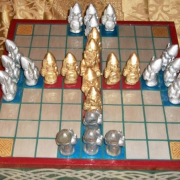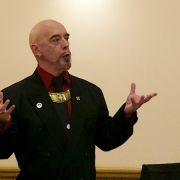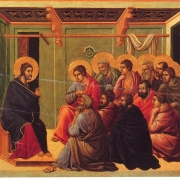The Odinic Pantheon – Preliminary ideas and a statement of purpose
In its resurgence over the past century Odinism has sometimes lacked credibility due to a tendency on the part of its adherents to refer to our deities in what can best be described as a literary fashion. They are seen as characters in old stories, the gods and goddesses depicted as human beings writ slightly larger than life. The old caricatures penned by Snorri Sturlasson are accepted for the most part without qualm and we have developed a habit of thought which sees Odin as an old man with one eye, dressed in a blue cloak, and Thor as a rather bumbling buffoon, red-bearded and bad tempered, who is prone to making an ass of himself.
We cut ourselves off from the gods by conceiving them as existing in some past age, dressing them as idealised vikings or medieval women in trailing skirts. When we attempt to alter this image we produce what is really an ideal human archetype, as was done once in the magazine Runestone, when Freya was described as a strong, maternal blond with a 45 strapped to her hip.
Odinism has in fact become a sort of heroic atheism, decorated with quaint stories. We intuitively turn to the gods of our people but seem unable to picture them as a reality. We view them as if they were lost in a bygone age, inaccessible, historical figments.
To build Odinism into a valid and inspiring religious expression we must overcome this tendency to trivialise divinity. The gods are not vikings or pistol-packing female guerilla fighters. They are spiritual beings, potent forces of numenous power and transcendent wonder. They are the driving force, the inspiration behind every creative enterprise and valiant deed performed by our people. In a very real sense they are the creators, the shapers, the progenitors of all the kindred folk of northern Europe.
Unlike the god-thing of Judeo-Christianity they do not demand fear and crawling adulation. They do not ask to be worshipped by fawning “sheep” on bended knees and with heads bowed. We approach our gods standing erect and with heads held high. We worship them with joy. For we are their people, their Will in the World of Form is worked through us.
We are the divine connection between the worlds and our relationship with divinity should be close and intimate one.
The Circle of Ostara is dedicated to this concept, that our religion must provide three things if it is to become a valid alternative to monotheism:
- A profound sense of the numenous and a realisation of the transcendent reality of our gods and goddesses;
- A mythology that is relevant in today’s world and which can evoke a deep intuitive response;
- Hope for the future, both in a spiritual and material sense.
This must be understood before we go on to consider the Northern Pantheon in more detail.




